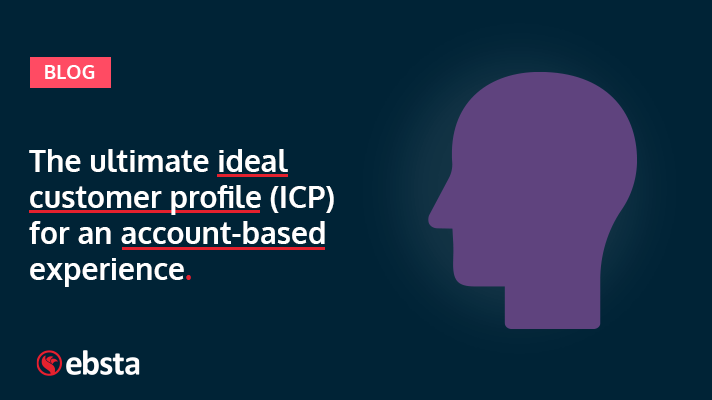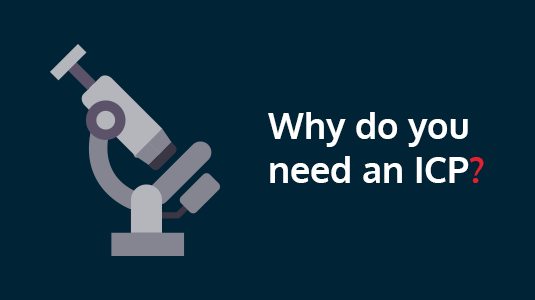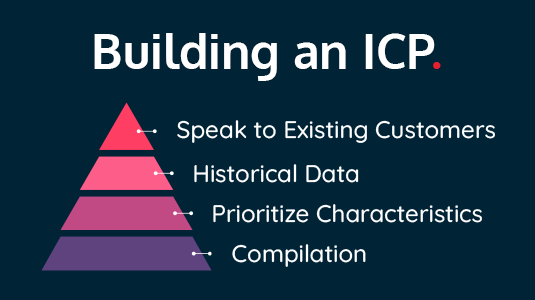Share this article
Learn from the brightest minds how to predictably and efficiently grow revenue.
Related Content
5 Ways to Use the Ebsta Integration With HubSpot to Improve Sales Performance
How to improve adoption of HubSpot with Ebsta
B2B Sales Benchmarks: 2023 H1 Update
The latest update from the 2023 B2B Sales Benchmarks analysis of over $37bn in pipeline.
How to improve AE quota attainment (according to data)
23% of reps are contributing 83% of revenue. Here's how to solve it (with data)

The Ultimate Ideal Customer Profile (ICP) For An Account-Based Experience
It’s the start of the year and you’ve been handed a list of leads.
How do you prepare yourself to turn as many of these leads into opportunities for your pipeline?
Introducing the ideal customer profile…
What is an ICP?
An ideal customer profile is a fictitious description of businesses that will experience the most value from your product or solution.
You are essentially looking for the ‘perfect’ customer. An ICP is a shortcut to understanding your leads.
What does their industry look like, what do they commonly have problems with, what does their tech stack look like? These are only some of the questions you will have answers to.
It is simple and easy and gives you back the time to do what you do best. Sell.
Why do you need an ICP?
There’s only so much information you can glean from someone’s LinkedIn profile. The value of using ICPs for account-based experience is to get under the skin of who you are targeting.
Gaining a deeper understanding of your target persona allows you to recognize how to sell to them with more of a personal touch.
Being equipped with information on their industry, budget, customer base, etc. empowers you to make intelligent sales plays. You’ll be two steps ahead before you even pick up the phone or send that first email.
You do not want to waste your time and resources on leads that are extremely unlikely to close. Building an ICP will allow you to identify the characteristics of customers which you have already successfully closed.
In layman’s terms, here is the easiest way to explain why building an ICP is so important for businesses. Salespeople can sell to everyone but the fact of the matter is not everyone will buy or has a need for your product or solution.
This is one of the biggest reasons for low customer retention rates. Sooner or later your customers will realize that your product serves no purpose to their business. ICP will help you to better meet the needs of your clients over longer periods of time.
In the shorter term, ICPs can contribute to lowering your churn rate as you will be targeting accounts that are more likely to stick with your solution.

Building an ICP
Step 1 – Speak to Existing Customers
The best place to start uncovering characteristics that are not quantifiable is to speak to your customers directly. Make a list of your best customers as they are an invaluable asset.
This will give you a chance to ask open-ended questions such as ‘why did you purchase our solution?’
Advocates for your brand are likely to be more than happy to set up a meeting with you. However, for other customers, it is important to show them the value of speaking with you. You could approach them with the intention to improve the quality of their service. They are more likely to be open with their experience if they feel it is benefitting them in some way.
Another factor to consider is leveraging existing relationships. For example, if an AE has already formed a relationship with one of your best customers, the same AE should be the one to reach out to this customer.
Here are some example questions for you to consider:
- What attracted you to our product initially?
- What specific parts of our product have you found to be the most useful?
- What parts of our product would you change?
- How do you use our product on a day to day basis?
- What does their perfect solution look like?
- What triggered them to buy your product in the end?
Step 2 – Historical Data
The next step in building your ICP is looking at your historical data. Using the list of your best customers you can take a look at your raw data to identify what characteristics they have in common. Here are some characteristics that you should definitely look into that will really start to shape your ICP.
Firmographics
- What industry are they in?
- What is the average size of the company?
- How many employees do they have?
- How much revenue do these companies make on average?
- Where are your accounts based?
- What is their predicted deal size?
- What are their business goals?
- What are they doing currently to achieve these goals?
Technographics
- What does their tech stack look like?
- How technically sophisticated are they?
Financial
- What was the minimum they would need to spend on your product?
- Do they have the budget to afford your product?
Behavioral Data
- Who was on the buying committee?
- What was the strength of your relationships with the buying committee?
- Which stakeholders are involved at which stage?
- What job titles do your champions have?
- What is their average age range?
- Where do they go to find information?
- What features are on their wishlist?
- What fears do they have?
Sales Data
- What type of accounts have a high NPS (net promoter score)?
- Which accounts have high retention rates?
- What was the average sales cycle?
- What was the average close rate?
- What level of activity do you need to close an account?
Step 3 – Prioritize Characteristics
You want to prioritize your most desirable attributes. You can do this by identifying similar characteristics of your top-performing accounts. For example, are they in the same location, the same industry, the same type of company, etc.
We recommend sticking with 5 to 10 key attributes. The purpose of this exercise is to narrow down a certain number of target customers so having a long list of attributes defeats the point. The value of narrowing down these characteristics is to provide everyone in your business with a clear definition of who your ideal customer is and who is not.
For example, if your software is only compatible with Salesforce, you want to ensure the leads you are reaching out to are using Salesforce.
With this information, you now have built a standardized procedure for who you are trying to target. Standardizing this process allows you to benchmark performance over time and look for opportunities to improve. By understanding what is working well, you can incorporate this into your approach and refine your strategy further. On the opposite side of this, you can avoid businesses that do not fit the bill.
Step 4 – Compilation
Last but not least you need to compile all this information. There are several formats that you can adopt depending on what suits your business. One way to compile this information in a simple way is by creating a short description of your ICP. Here is an example:
Our ideal customer is a FinTech company in the UK or US that has at least 1000 users with a minimum budget of $50,000. Their buying committee usually consists of CFOs, general managers of finance, and payment managers.

How To Use Your ICP?
The best way to use your ICP is for prospecting. So, when you get a long list of leads and you do not know where to start, you can pull out your ICP.
By comparing the details of your leads to your ICP, you can prioritize the businesses to focus on first. This makes you better equipped to engage with them. You will be able to hit the ground running as your approach is more effective.
You are automatically generating more qualified pipeline. Not only does this save your time and resources, but it also helps you get your foot in the door with businesses that are ready for your solution.
ICPs are also extremely useful for selling purposes as they can be leveraged to target leads. You will have access to information on how they operate, what their pain points are and can sell your solution with their goals in mind. This is what will really set you apart from your competitors.
Building an ideal customer profile goes hand in hand with account-based selling strategies as it allows you to focus your efforts on generating high-quality sales leads.
In the current climate, the speed of the sales cycles is increasing faster than ever before. Your business needs to provide value immediately to leads and building your ICP is the way to do it.
